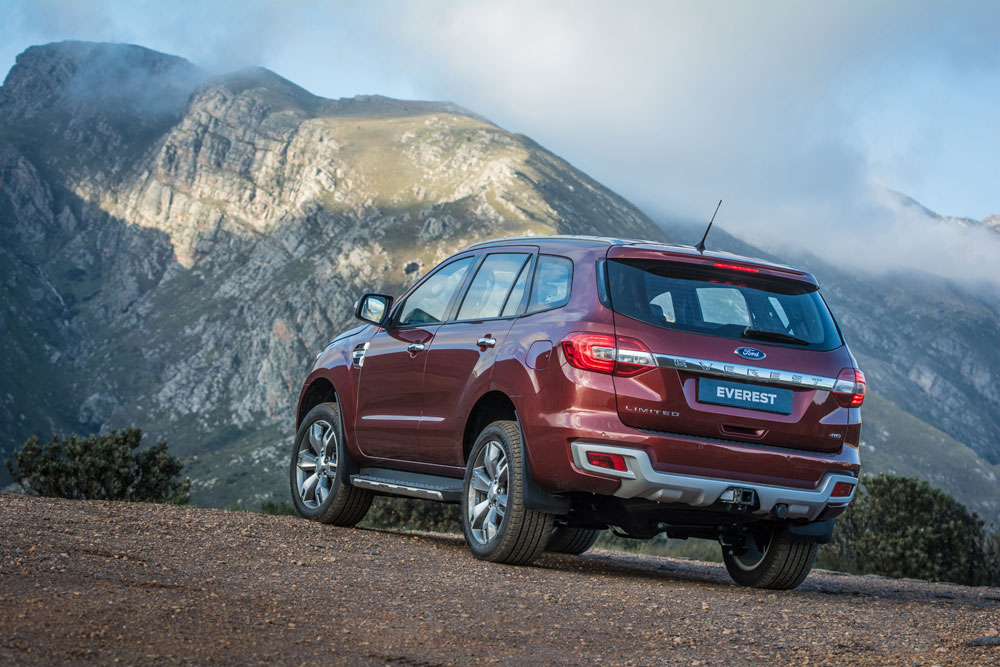There is finally an SUV on the market capable of challenging Toyota's dominance of the segment through its Fortuner.

The Ford Everest has been around a while, but was basically so ugly it could not be taken seriously. The new Ford Everest is however a whole different ballgame. Not only is the styling so much of an improvement that it is worth looking inside, but it is a technological leap forward as well. Initially available only powered by a version of Ford’s well known 3.2-litre turbo diesel and only four wheel-drive it will be playing in the top end of that market. Ford must be confident that the new Everest is enough of a game changer to stretch customers into the R600 000 territory, but less expensive derivatives will follow in time. For now there is XLT-spec and a Limited-spec. Strange to call the higher end model “limited”, but such is automotive ambiguity.
The Everest is such an aesthetic improvement on its predecessor that the few people familiar with the old version, probably after an encounter with the traffic authorities who appear to have been its only significant customer, could be forgiven for not identifying the new version at all. It sports the biggest Ford badge fitted to a road vehicle to date, even Ford see it as something to celebrate.
The robust front end with signature LED daytime running lights and wide stance make for a powerful presence on the road. The chiselled and technical design is also highly efficient – extensive aerodynamic testing led to an exterior that seamlessly melds form and function. The all-new Everest’s bold exterior presence is paired with a modern interior that makes use of refined materials and emphasizes horizontal lines to create a comfortable, harmonious environment for up to seven adult occupants.
Interior features balance ride comfort with ultimate practicality, with standard folding second and third-row seating, more than 30 cleverly designed stowage spaces, multiple power outlets and flexible seating and cargo arrangements to achieve a perfect balance between passenger demands and packing efficiency. On the high-spec Everest Limited, the third-row seats feature a power-fold function, a powered tailgate and an optional dual-panel moon roof. It even has a 220-volt power plug for the middle row of seats, although I would prefer to see this up front so that curious children are unable to put paper clips into it, just to see what happens.
To ensure exceptional cabin quietness, Ford equipped the all-new Everest with Active Noise Cancellation technology in addition to optimizing cabin sealing and sound absorbing materials throughout the vehicle.
This is complemented by an exceptional level of safety features including seven airbags, driver assist technologies such as Electronic Stability Program (ESP) with Roll Stability Control, cruise control, as well as rear park assist with rear view camera. The XLT features 18-inch alloy wheels and running boards as standard.
As the flagship of the all-new Everest range, the Limited model features innovative driver aids such as Active Park Assist, Adaptive Cruise Control, Auto High Beam Control, Blind Spot Monitoring with Cross Traffic Alert, Tyre Pressure Monitoring, Lane Departure Warning and Lane Keep Assist. Exterior enhancements include 20-inch alloy wheels, high intensity discharge (HID) headlamps and LED daytime running lights.
The basis of the Everest’s strength is a body that rests on a ladder frame in true offroader tradition. Together with an intelligent four-wheel drive system, an active transfer case with torque on demand, a ground clearance of 225mm and water-wading capability of 800mm, the Everest should prove extremely capable where the rough stuff starts.
An advanced new terrain management system gives drivers four settings – Normal, Snow/Gravel/Grass, Sand and Rock – that alter the vehicle’s throttle response, transmission, intelligent four-wheel drive system and traction control to confidently tackle any situation. For extreme off-road environments, drivers can manually lock the transfer case in low-range four-wheel drive mode for increased traction.
Ford have opted for a coil spring front and rear suspension for ride comfort, but a solid beam live axle at the rear for better articulation off road. A thing called a Watt’s linkage on the rear axle overcomes the disadvantage of a solid axle on road. What’s that you may well ask? A Watts axle designed by the great James Watt for his famous steam engine, consists of two bars running laterally from each wheel to a pivot point on the differential that prevents lateral movement of the axle while allowing unhampered vertical movement. Indeed the Everest’s on road handling and stability was impressive, thanks James.
The five cylinder engine produces 147kW and 470Nm and is matched to a smooth-shifting six-speed automatic transmission with Sports shift mode as standard. Sports shift is a bit of a stretch and the Everest is no drag racer, but acceleration is adequate.
The real strength is in the torque and the Everest may tow up to 3 000kg, matched to a 750kg payload. Furthermore, it is capable of carrying 100kg of cargo on the standard-fit roof racks.The Everest is however not just about brute force and Ford have brought it dramatically up to date with technologically too.The latest generation of Ford’s in-car connectivity solution, Sync2, recognises 10 000 natural voice commands to control the car’s entertainment system, climate control and connected mobile devices more easily than ever before. Sync2 also boasts an eight-inch touchscreen with colour-coded corners for easy menu navigation. The entertainment system features a top-end 10-speaker sound system with an integrated subwoofer, providing accurate and precise sound reproduction and deep, rich bass.
Other advanced technologies include Curve Control, designed to help drivers maintain control when approaching turns too quickly, and Blind Spot Information System (BLIS) with Cross Traffic Alert on the Limited model, which informs drivers when there is a vehicle in their blind spot while driving or when preparing to reverse out of parking spots.
The vehicle also offers other advanced features, including Roll Stability Control and an Electronic Stability Program that works with traction control to help the driver stay in control. Active Park Assist on the all-new Everest Limited enables drivers to parallel park hands-free, requiring only accelerating, shifting and braking from the driver. Passive safety features include seven airbags to help to keep occupants safe in the event of a collision.
Ford are obviously pretty confident that they have a winner as they appear to have no intention of competing on price with the Everest XLT 3.2L 6AT 4X4 coming in at R593 900 the Limited 3.2L 6AT 4X4 at a whopping R646 900.









